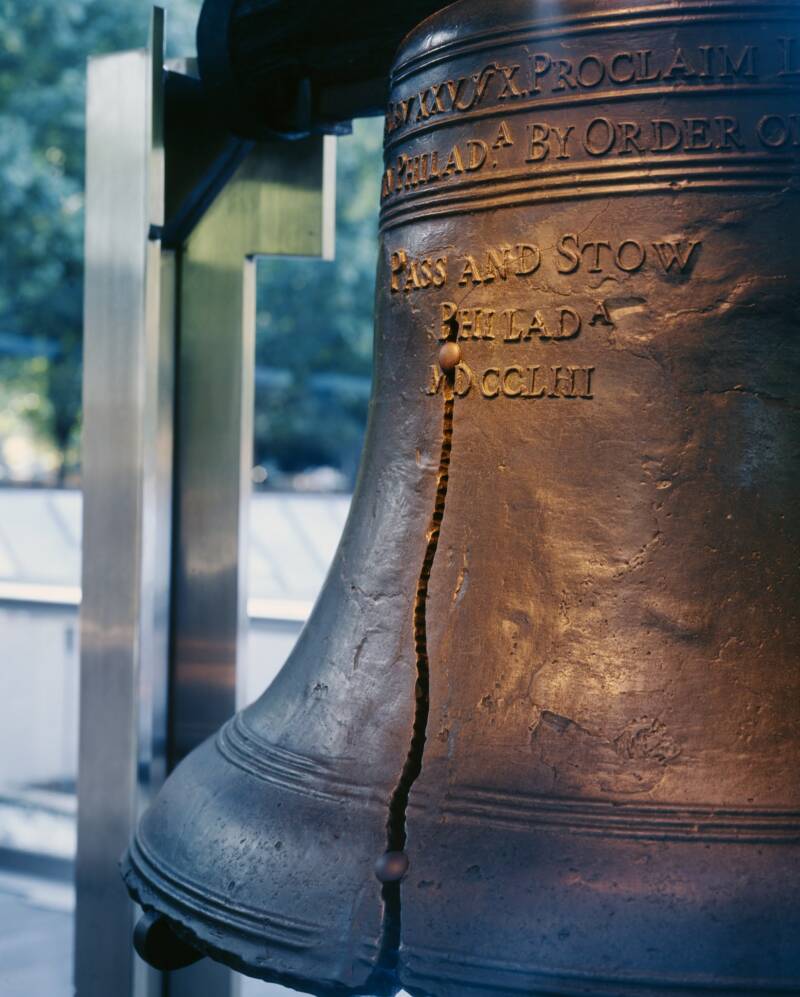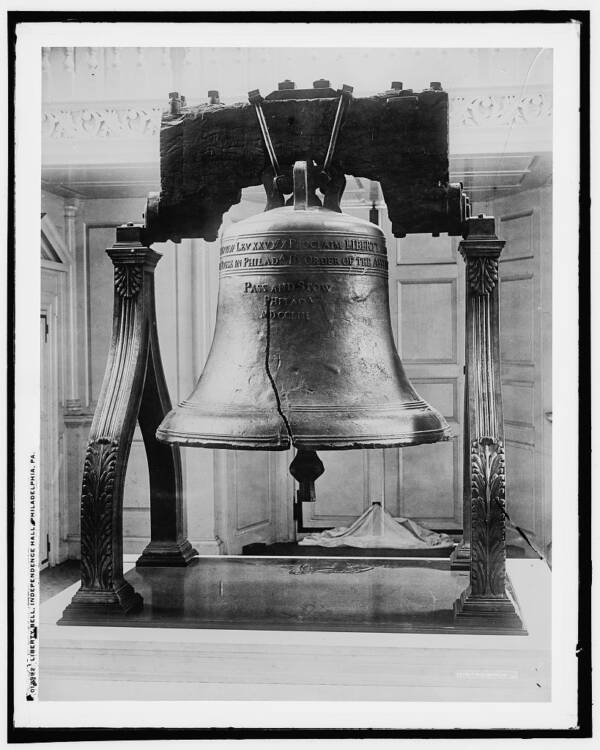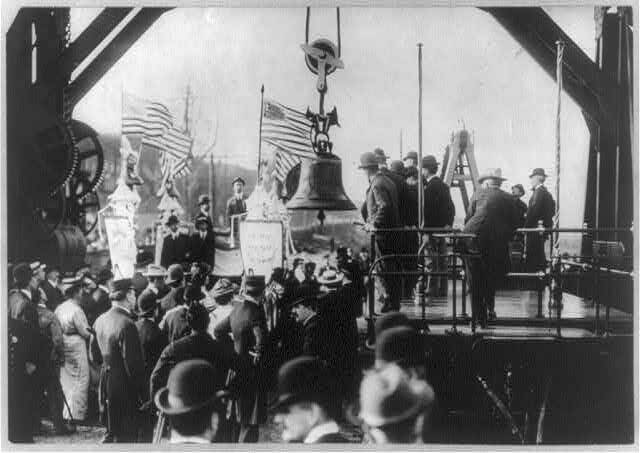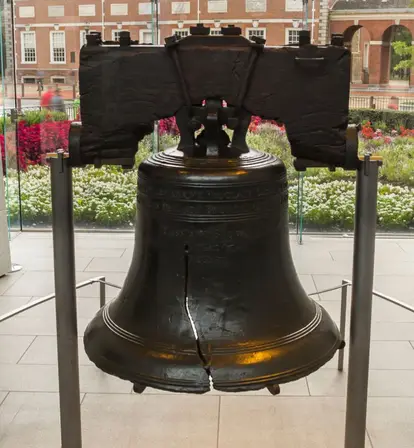How and why the Liberty Bell cracked is difficult to determine, but there are many theories that explain the origin of the iconic symbol's beloved flaw.
Of all the symbols of American independence, the Liberty Bell in Philadelphia is among the most famous. It’s especially famous for its flaw: the large crack that runs up its side. So how did the Liberty Bell crack?
The story zigs and zags like the famous crack itself. Fundamentally flawed when it first arrived in the United States, the Liberty Bell would go on to play an important role in Revolutionary War, the rise of abolitionism, and women’s suffrage. Yet some parts of its story are hazy.
Why did the Liberty Bell crack? The answer is ambiguous and may have to do with the Marquis de Lafayette, the death of Chief Justice John Marshall, or plans for George Washington’s birthday celebration.
The Flawed Bell Arrives From England
Though the Liberty Bell came to symbolize American Independence, it came from England. Speaker of the Pennsylvania Assembly Isaac Norris ordered the bell from the Whitechapel Foundry in London in 1751 for the Pennsylvania State House (the future location of debates over the Declaration of Independence and the Constitution, and called Independence Hall today).
But when the bell was tested, it immediately cracked. According to the Independence Hall Association, the bell was then melted down by metalworkers John Pass and John Stow, who added copper to make the bell less brittle. But they apparently added too much and ruined the bell’s toll.

Library Company of PhiladelphiaIndependence Hall depicted in 1776.
“Upon trial, it seems that they have added too much copper,” Norris complained in a 1753 letter. “They were so teased with the witticisms of the town that they… will very soon be ready to make a second essay.”
The bell was recast again. And though its toll still didn’t satisfy Norris, it was hung in at the Pennsylvania State House, inscribed with Pass and Stow’s names, as well the Biblical quote: “Proclaim Liberty throughout all the land unto all the inhabitants thereof.” Norris apparently chose this quote to mark the 50th anniversary of William Penn’s 1701 Charter of Privileges, which guaranteed religious freedom and self-governance in Pennsylvania.

Library of CongressPass and Stow’s names are visible on the Liberty Bell to this day.
The ringing of the bell — which announced the time, called lawmakers to meetings, and marked the reading of news — would have been a familiar sound for Philadelphians, including Benjamin Franklin. The National Park Service reports that Franklin ended a 1755 letter with the line: “Adieu, the Bell rings, and I must go among the Grave ones and talk Politicks.”
In the tumultuous final decades of the 18th century, the bell rang more frequently than ever. It marked important occasions like the meeting of the First Continental Congress in 1774 and the Battle of Lexington and Concord in 1775. However, the bell likely did not ring in July 1776 to mark the reading of the Declaration of Independence — as suggested by George Lippard’s 1847 story Ring, Grandfather, Ring — because the steeple was in poor condition.
In fact, the bell didn’t ring at all during the Revolutionary War. Weeks before the British marched to Philadelphia, the bell was hidden beneath the floorboards of a church in Allentown.
So how did the Liberty Bell crack?
How Did The Liberty Bell Crack?
Though it’s unknown when the Liberty Bell first started cracking, its final crack appeared in the 1840s. As the city prepared to mark the 115th anniversary of George Washington’s birth in February 1846, metal workers widened a hairline crack on the bell to stop it from vibrating against itself and cracking further. But this repair job failed to prevent other cracks from forming.
“The old Independence Bell rang its last clear note on Monday last in honor of the birthday of Washington and now hangs in the great city steeple irreparably cracked and dumb,” the Philadelphia Public Ledger lamented.

Library of CongressThe Liberty Bell in 1901, about 55 years after it cracked and was retired from use after George Washington’s 115th birthday.
The paper continued:
“It had been cracked before but was set in order of that day by having the edges of the fracture filed so as not to vibrate against each other… It gave out clear notes and loud, and appeared to be in excellent condition until noon, when it received a sort of compound fracture in a zig-zag direction through one of its sides which put it completely out of tune and left it a mere wreck of what it was.”
How the bell cracked originally, however, is up to debate. HISTORY notes that the bell could have been damaged in 1824, either while celebrating the arrival of the Marquis de Lafayette, a Revolutionary War hero, or sounding the alarm about a fire. The bell could also have been damaged a decade later during the funeral of Chief Justice John Marshall in 1835. However, newspaper accounts of his funeral don’t mention damage to the bell.
In any case, the Liberty Bell apparently started cracking in the 19th century. Concurrently, it started to become an important American symbol.
How The Cracked Liberty Bell Became A Symbol

Library of CongressThe Liberty Bell in St. Louis, where it was displayed during the St. Louis Exposition in 1904.
The Liberty Bell wasn’t even called the Liberty Bell until the 1830s, when its cracks were probably already forming. In 1837, an abolitionist publication called the Anti-Slavery Record tied the bell to the abolition movement for the first time by referencing its famous inscription. Two years later, abolitionist newspaper publisher William Lloyd Garrison published a poem called “The Liberty Bell,” the first documented use of the term.
“Ring, ring the mighty Bell,
In the storm, in the storm!
Brothers! It shall herald well
Fair Freedom’s form.
Ring it Southward, till its voice
For slavery toll, for slavery toll;
And Freedom’s wakening touch rejoice
Both limb and soul.–The Liberty Bell, 1839
After the Civil War, the Liberty Bell went on a national tour that cemented its place in American history. It was also later used by other groups, including female suffragettes, as a powerful symbol of liberty.
Today, the Liberty Bell — crack and all — is displayed in Philadelphia. The question of how the Liberty Bell cracked may be somewhat difficult to answer, but there’s no question about the bell’s importance. A symbol of unity and freedom, the Liberty Bell embodies the American story, and, perhaps, the ongoing American desire to “form a more perfect Union.”
After reading about how the Liberty Bell cracked, delve into these surprising facts about the Statue of Liberty, another iconic symbol of the United States. Or, look through these dark facts about America’s Founding Fathers.






